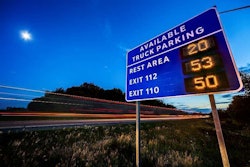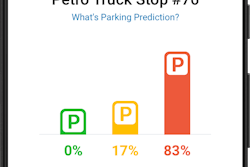 All seven Connecticut rest areas could close completely to the public on July 1 if new revenue isn’t found for the state’s Special Transportation Fund.
All seven Connecticut rest areas could close completely to the public on July 1 if new revenue isn’t found for the state’s Special Transportation Fund.Budget woes for the Connecticut Department of Transportation could result in the closure of the state’s seven rest areas, meaning a loss of more than 200 truck parking spaces in a state that already faces a truck parking shortage.
The closure of the seven rest areas would not affect the state’s 23 service plazas, which are are partially state owned but privately operated. They have parking spaces, food vendors and fuel. The rest areas only provide a small building with restrooms, and in some cases a vending machine, along with parking.
Connecticut DOT spokesman Kevin Nursick said his department conducted a study several years ago that revealed a truck parking deficit of 1,200 spaces each night. The seven rest areas under threat of closure offer truckers a total of 222 parking spaces that could be lost.
The locations of the seven rest areas are located along I-84 Eastbound at Danbury, Southington and West Willington, and I-84 Westbound at West Willington; I-91 Southbound at Wallingford and I-91 Northbound at Middletown; and I-95 Southbound at North Stonington.
Nursick said the state’s Special Transportation Fund, which funds highway and bridge projects, public transit, the rest areas and much more, is on track to be insolvent in the next two or three years, and as a result, CTDOT has to “curtail, eliminate, cut and postpone roughly $5 billion in projects,” he said.
Connecticut Gov. Dannel Malloy has already halted major transportation projects in the state due to the lack of funding. Malloy said in a recent press conference, according to Hartford, Conn., news station WFSB, the fund is depleted because the gas tax isn’t creating enough revenue, and debt payments are increasing.
“Come July 1, if the issue isn’t resolved, these seven rest areas are closing,” Nursick said. “No public access. That will save around $400,000.”
When the Connecticut General Assembly passed its fiscal year 2017 budget in the summer of 2016, Nursick says funding to keep the rest areas open was cut from the DOT’s budget. At the time, the rest areas were still operating 24 hours a day. After the cut in funding, Nursick said the DOT scraped together as much money as possible to keep the rest areas open in some capacity.
Last year, portable toilets were brought in to the seven locations, and the actual buildings containing restrooms were cut down to just one shift per day, from 8:30 a.m. to 3:30 p.m. After that, parking was still open, but the only restroom facilities available were the portable toilets.
“It became apparent very quickly we couldn’t keep these facilities staffed 24/7, so we created a reduced schedule and brought in the portables,” Nursick said. “This saved us about $2 million a year, but we still had to pay a staff for that one shift without any funding at all.”











